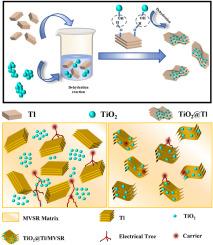新型TiO2@Tl纳米颗粒增强硅橡胶介电复合材料性能
IF 7.7
2区 材料科学
Q1 MATERIALS SCIENCE, COMPOSITES
引用次数: 0
摘要
改善填料分散性和提高储能性能是硅橡胶介电复合材料的必要条件。在本研究中,开发了一种新的策略来克服极性填料在非极性硅橡胶中分散性差的局限性。本研究通过填料表面羟基的脱水反应,将二氧化钛(TiO2)纳米颗粒固定在滑石(Tl)纳米薄片上,合成了一种新型填料TiO2@Tl。TiO2@Tl结合了TiO2和Tl的优点,减少极性羟基的数量,使其极性减弱,显著增强了与甲基乙烯基硅橡胶(MVSR)的相容性。与直接在MVSR中添加两种填料TiO2和Tl (TiO2-Tl/MVSR)相比,TiO2@Tl/MVSR复合材料在同等填料水平下具有更均匀的填料分散和更好的综合性能。10 wt%TiO2@Tl/MVSR复合材料的最高储能密度为95.55 kJ/m3,与纯MVSR (67.15 kJ/m3)相比增加了42.2%,与5wt% TiO2-5wt%Tl/MVSR (84.39 kJ/m3)相比增加了13.2%。本文章由计算机程序翻译,如有差异,请以英文原文为准。

Enhanced properties of silicone rubber dielectric composites by incorporation of novel TiO2@Tl nanoparticles
It is necessary for silicone rubber dielectric composite to improve filler dispersion and enhance energy storage performance. In this study, a novel strategy is developed to overcome the limitations associated with the poor dispersion of polar fillers in non-polar silicone rubber. This study anchors titanium dioxide (TiO2) nanoparticles onto talc (Tl) nanoplatelets by dehydration reaction of hydroxyl groups on filler surface to synthesize a novel filler TiO2@Tl. TiO2@Tl combines the advantages of TiO2 and Tl, and reduces the number of polar hydroxyl groups to weaken its polarity, which significantly enhances the compatibility with methyl vinyl silicone rubber (MVSR). Compared to directly adding two fillers TiO2 and Tl into MVSR (TiO2-Tl/MVSR), TiO2@Tl/MVSR composite exhibits the more uniform filler dispersion and better overall performance at equivalent filler levels. 10 wt%TiO2@Tl/MVSR composite exhibits the highest energy storage density of 95.55 kJ/m3, representing a 42.2 % increase compared to pure MVSR (67.15 kJ/m3) and a 13.2 % increase compared to 5 wt%TiO2-5wt%Tl/MVSR (84.39 kJ/m3).
求助全文
通过发布文献求助,成功后即可免费获取论文全文。
去求助
来源期刊

Composites Communications
Materials Science-Ceramics and Composites
CiteScore
12.10
自引率
10.00%
发文量
340
审稿时长
36 days
期刊介绍:
Composites Communications (Compos. Commun.) is a peer-reviewed journal publishing short communications and letters on the latest advances in composites science and technology. With a rapid review and publication process, its goal is to disseminate new knowledge promptly within the composites community. The journal welcomes manuscripts presenting creative concepts and new findings in design, state-of-the-art approaches in processing, synthesis, characterization, and mechanics modeling. In addition to traditional fiber-/particulate-reinforced engineering composites, it encourages submissions on composites with exceptional physical, mechanical, and fracture properties, as well as those with unique functions and significant application potential. This includes biomimetic and bio-inspired composites for biomedical applications, functional nano-composites for thermal management and energy applications, and composites designed for extreme service environments.
 求助内容:
求助内容: 应助结果提醒方式:
应助结果提醒方式:


